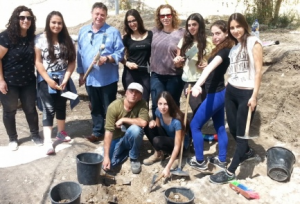
Dr. Daphna Ben-Tor, curator of Egyptian archaeology at the Israel Museum in Jerusalem, who identified the scarab amulet, added that “this is an Egyptian scarab from the times of the Ramses, the 19th Dynasty, the golden days of the pharaohs of Egypt.”
By Yori Yalon
Tzipori (Sepphoris) in the Galilee has revealed another exciting find: On Tuesday, a group of young students participating in an archaeological excavation run by the Israel Antiquities Authority at the ancient site discovered an Egyptian amulet that is over 3,000 years old.

The Egyptian amulet dates back to the 19th Dynasty – Photo: Israel Antiquities Authority
Like so many important archaeological findings in Israel, the object was uncovered at a dig being conducted as part of preparations for an infrastructure project — in this case, a new access road.
The students who dug up the amulet were among the 350 10th graders from the ORT Kiryat Bialik high school who have spent this week helping with IAA excavations throughout the Galilee under the auspices of an Education Ministry program designed to increase young people’s connection to their communities and surroundings.
“The excitement over the discovery was immense, and the girls’ eyes lit up,” excavation director Nimrod Getzov said.
“When I came closer to see what had been found, I was surprised to see that it was an Egyptian amulet, because things like this are usually found in graves. Our excavation focuses on periods that pre-date the amulet, and it’s intriguing how it happened to wind up here,” Getzov said.
Dr. Daphna Ben-Tor, curator of Egyptian archaeology at the Israel Museum in Jerusalem, who identified the scarab amulet, added that “this is an Egyptian scarab from the times of the Ramses, the 19th Dynasty, the golden days of the pharaohs of Egypt. The scarabs were mostly used as amulets for anyone who could afford one. In most cases, they were used as burial amulets, but also [worn] by the living, and were generally originally set in rings.”
Gilad Zinamon, education coordinator for the IAA in northern Israel, said that “you can learn a lot in history class, but there’s nothing like discovering you’re holding a greeting from the past in your hands to form a connection with the legacy of this country. Most of the students told us this was the first time they’d encountered the world of archaeology, and it’s touching to see the interest and curiosity they show at the dig.”
View original Israel Hayom publication at:
http://www.israelhayom.com/site/newsletter_article.php?id=34039






 Israeli New Shekel Exchange Rate
Israeli New Shekel Exchange Rate